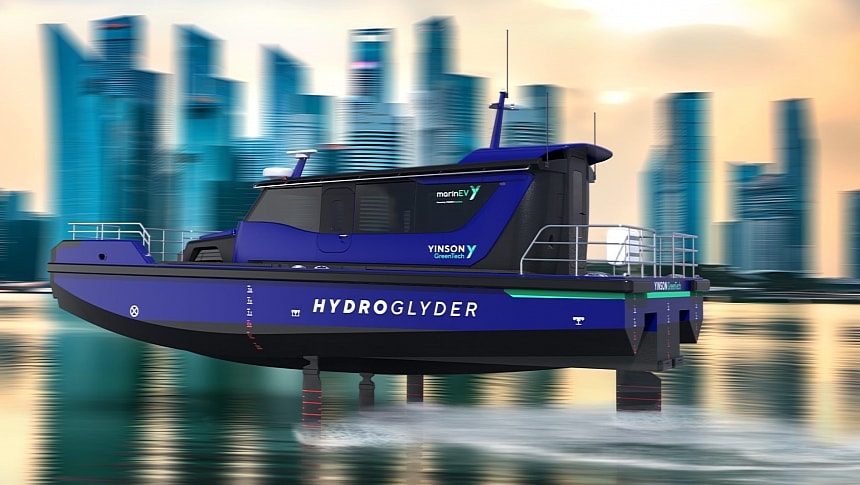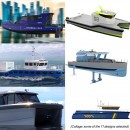This innovative battery-electric vessel for crew transfer was one of only six selected by the Singapore Maritime and Port Authority (MPA) to work directly with this institution and its associated researchers for full validation and market readiness.
Singapore's MPA announced the 11 companies that were selected at the end of its electric harbor craft (e-HC) competition. The project was launched last summer with the goal of finding the best e-HC designs for the Singapore market. More than 30 domestic and international companies submitted a total of 55 proposals. Only 11 were selected in the end, and only six of these will be working directly with MPA and with the project's lineup of prestigious research institutions over the following months.
One of the six lucky ones is the Hydroglider, an electric vessel concept developed by marinEV, a business of Yinson GreenTech (YGT). As its name suggests, YGT is the green technology unit of Yinson, an energy infrastructure and technology giant based in Malaysia. This green tech company is only four years old but is not limited to a single sector. Its projects range from urban mobility and autonomous vehicles to electric charging infrastructure.
The Hydroglyder is one of the two vessel concepts in marinEV's range. The Hydromover is a light cargo vessel, while the Hydroglyder is a crew transfer vessel, both fully electric. Classified as an electric harbor craft, the Hydroglider is a catamaran with a center hull running on batteries.
It's under 12 meters long (39 feet) and designed to safely carry up to 12 passengers, in addition to a two-person crew. This modern take on harbor transportation combines the benefits of battery-electric propulsion with cutting-edge hydrofoil technology and also incorporates several other modern technologies.
As an electric hydrofoil vessel, the Hydroglyder promises a power reduction of up to 80% compared to non-foiling ships and energy-cost savings of up to 90%. According to the manufacturer, every feature was carefully selected to optimize energy efficiency, from the lightweight hull made of composite materials to the mode-based operations that can adapt to different operational profiles.
One of the Hydroglyder's innovative features uses the benefits of 3D printing. This vessel comes with 3D-printed passenger seats that are optimized for maritime operations. This means that they're as lightweight as possible and also ergonomically designed for better comfort (and are even easier to clean).
Auto-docking is another high-tech feature, and the Hydroglyder is even meant to be adapted for fully autonomous operations in the future. Performance-wise, it promises a top speed of 30 knots (55.5 kph) and a 15-nautical mile (27.7 km) range, plus efficient battery swapping for minimal downtime. Apart from operating with zero emissions, this modern harbor vessel is also equipped with state-of-the-art navigation systems and sensors that could enable safe, autonomous operations in the future.
One of the six lucky ones is the Hydroglider, an electric vessel concept developed by marinEV, a business of Yinson GreenTech (YGT). As its name suggests, YGT is the green technology unit of Yinson, an energy infrastructure and technology giant based in Malaysia. This green tech company is only four years old but is not limited to a single sector. Its projects range from urban mobility and autonomous vehicles to electric charging infrastructure.
The Hydroglyder is one of the two vessel concepts in marinEV's range. The Hydromover is a light cargo vessel, while the Hydroglyder is a crew transfer vessel, both fully electric. Classified as an electric harbor craft, the Hydroglider is a catamaran with a center hull running on batteries.
It's under 12 meters long (39 feet) and designed to safely carry up to 12 passengers, in addition to a two-person crew. This modern take on harbor transportation combines the benefits of battery-electric propulsion with cutting-edge hydrofoil technology and also incorporates several other modern technologies.
As an electric hydrofoil vessel, the Hydroglyder promises a power reduction of up to 80% compared to non-foiling ships and energy-cost savings of up to 90%. According to the manufacturer, every feature was carefully selected to optimize energy efficiency, from the lightweight hull made of composite materials to the mode-based operations that can adapt to different operational profiles.
One of the Hydroglyder's innovative features uses the benefits of 3D printing. This vessel comes with 3D-printed passenger seats that are optimized for maritime operations. This means that they're as lightweight as possible and also ergonomically designed for better comfort (and are even easier to clean).
Auto-docking is another high-tech feature, and the Hydroglyder is even meant to be adapted for fully autonomous operations in the future. Performance-wise, it promises a top speed of 30 knots (55.5 kph) and a 15-nautical mile (27.7 km) range, plus efficient battery swapping for minimal downtime. Apart from operating with zero emissions, this modern harbor vessel is also equipped with state-of-the-art navigation systems and sensors that could enable safe, autonomous operations in the future.







